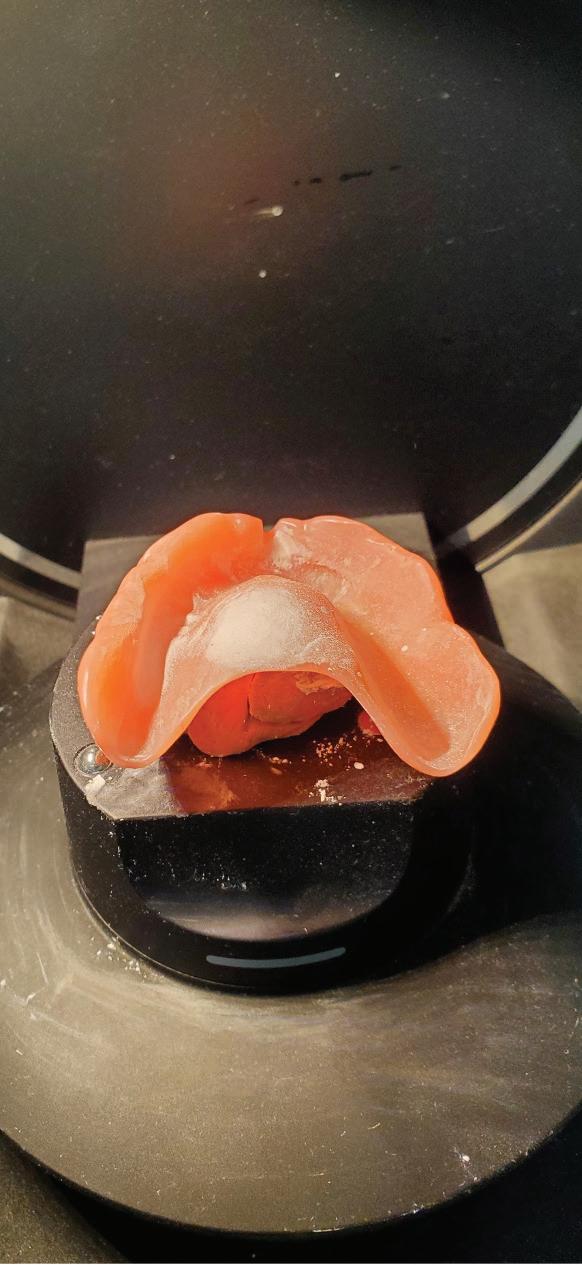
3 minute read
A freedom alternative to the consequences of bruxing
Digital copy denture fabrication for a bruxing/clenching patient
By Marc Wagenseil DD, RDT
Often, we encounter patients who exhibit bruxing/ clenching habits, which can cause premature wear of denture teeth. Treating this condition is difficult and frustrating as treatment options can be uncomfortable or expensive if dentures require replacement more frequently. An opportunity arose to challenge me to consider an alternative treatment option and craft a digital copy denture to address possible premature wearing of a denture due to suspected bruxing. The combination of traditional experience with emerging digital technology provided inspiration to “get out of one’s own way” and, ergo, challenge professional complacency. This article explores the treatment option of how to manage the consequences of bruxing/clenching, not the causes associated with it and how to prevent them.

Patient case
An existing patient to the practice presented for a recall appointment with an approximate two-and-a-half-year-old complete upper denture to natural lower dentition. Having been a patient for many years, she has exhibited bruxing/clenching tendencies, which have been present for decades. Many treatment options during her life have been explored with limited or no success.
These treatments have included hard and soft maxillary and mandibular splints, meditation, medications and hypnosis. The patient has learned trigger points which influence her bruxing and has also accepted the premature wearing of the denture teeth and with it, more frequent denture replacement. She must always wear the denture at night for temporomandibular joint support. Considering her condition, the existing denture was crafted with VITA Excell Anteriors and Lingoform Posteriors. These teeth were chosen for aesthetics, material durability (acrylic-glass) and Freedom in Centric design. A more detailed explanation is to follow.
Oval/Circular Ovoid Tear drop/Vertical
Although the denture was performing well during her recall appointment, slight premature wear was noted and discussions began on pre-emptive options.
Prior to her becoming a patient, her previous dentures had been crafted from acrylic teeth, which were well worn within a few years and fractured often. The current VITA product used in her denture was performing well and much better than acrylic teeth had. Since the option was now available, the decision was made to craft a digital copy of the existing denture, which she would wear at night or in trigger point situations. The thought was to have the copy denture bear the brunt of the consequences of bruxing/clenching and not the “good” denture. The existing denture was scanned using 3Shape and a copy made from Dentca tooth shade printable resin. This material was chosen with the expectation that it would be more durable than acrylic.
Treatment plan
In drafting the treatment plan, the copy denture would not be enhanced as the current denture was performing well. It functioned, fit, was comfortable, had not fractured and was not causing any issues to the supporting structures as had occured in previous dentures. The copy denture was to be worn at night or in trigger point situations.
Background information and theory
Existing denture teeth
Standard teeth available and used in most dentures are functional, with 10, 20 or 30-degree variety with the working and balancing cusp concept. However, the teeth are locked into a centric position and have no Freedom in Centric. Yes, they work and balance, but there is no “wiggle-room” in centric. In cases of single dentures, these denture teeth are ground into the natural teeth to achieve maximum contact and overlap and have no Freedom in Centric.
Freedom in Centric
Freedom in Centric is defined as “A flat area in the central fossae upon which opposing cusps contact, which permits a degree of freedom (0.5-1 mm) in eccentric movements uninfluenced by tooth inclines.” (Schuyler CH. Freedom in Centric. Dent Clin North Am. 1969;13:681-686.). All natural dentition have this concept, yet only a very few specific denture teeth available have it incorporated.
Why Freedom in Centric is important in dentures
This concept is important as denture teeth have no nerves. As such, a patient cannot feel when the teeth occlude or if they occlude properly. The important fact to remember is that there is food between the teeth during chewing and it is not possible to achieve perfect centric contact each and every time like we can achieve on an articulator during fabrication. What compounds the issue is that dentures are subject to moving as they fit against soft tissue.
Combine these points and it is not conceivable to think a denture patient can achieve perfect centric each time. This provides a reason as to why natural dentition has Freedom in Centric, even though we can feel our teeth, as it is not possible to achieve perfect centric each time we chew. With this in mind, the concern is the working cusps hitting the corresponding guiding planes, sliding into position. The hit and slide aspect is a source of denture issues and ill fit. When present, because the patient cannot directly feel it, they will try to grind away the offending contact, exasperating the bruxing/clenching condition. This is also often misdiagnosed. Freedom in Centric thus provides stability to dentures.
































